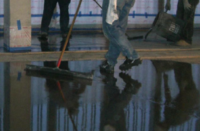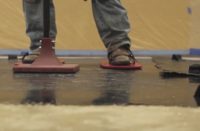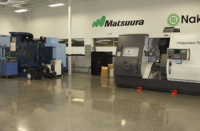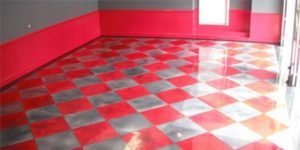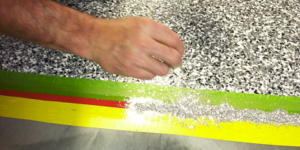Mike Ramy, owner of Precision Epoxy Products, a division of Rock Art Ltd. In Douglasville, Georgia, recalls his first epoxy job back in 1965 when he was just 13. “We coated the concrete of an 18-bay loading dock area and a forklift ramp up to the very large trash compactor/dumpster unit to nonskid the area of around 4,000 square feet,” he says, describing the broadcast-quartz floor installation at a large paper mill. “It was my introduction into weekend and holiday work while businesses are closed to minimize disruption to normal operations at a facility.”
His grandfather owned a painting business back then, and he spent summers and many weekends working with his dad and granddad. Back in the ’60s, when epoxies first came along, they were often specified in food-related areas because of their ease of cleaning and resistance to germs, he says. Ramy remembers the old guys didn’t want anything to do with epoxy, so they’d paint the walls and the young guys would handle the floors.
“That’s how I got started,” he says. And 49 years later, he’s still at it. Today, Ramy not only installs epoxy products but he also formulates them. He has a standard line customers can chose from, and he customizes formulas to fulfill specific needs.
“Floor coverings are our bread and butter,” he says. In his opinion, “Troweled quartz systems are very old-school. They’re something we don’t do much anymore for several reasons.” The first is that with 3M out of the quartz granularmaking business, spherical granules are no longer readily available, he says. “What you get today are jagged in shape and harder to trowel. They tend to lock together instead of spreading out nice and evenly.”
The second reason is cost. Ramy says he has a sand-filled epoxy mixture that can be troweled down as a floor base or used to level out “birdbaths” or puddling areas at one tenth the cost of quartz. Quartz can then be broadcast on top of that. “If customers want a thicker floor, you can do a triple or quadruple broadcast,” he says. If they want a troweled quartz nonskid surface, you’d have to come back and broadcast anyway.
Lastly, troweled quartz is not that popular anymore among his customers because of the labor factor. “You have to have workers very skilled at troweling. If the trowel crew is not on their game, you’ll have a crazy, wavy mess. Maintaining a uniform thickness over large areas is very difficult.”
